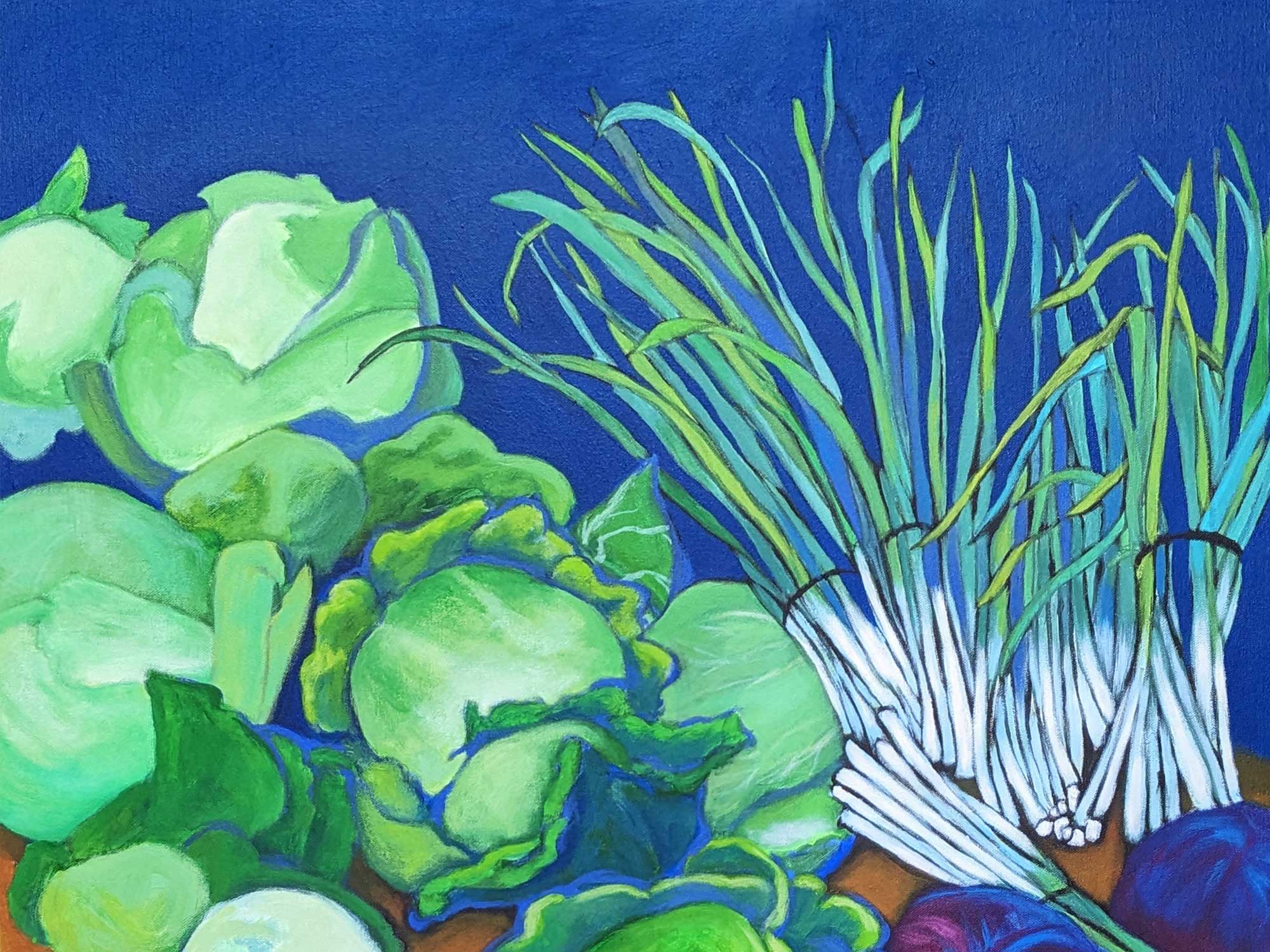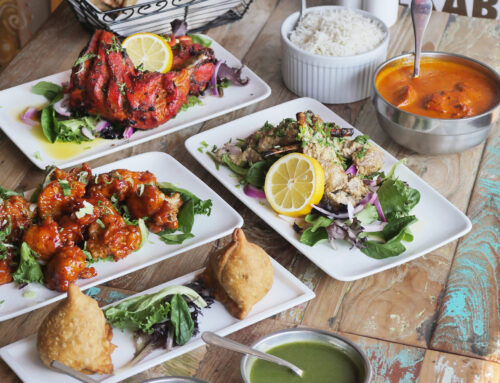Writing by Oliver Berke
Artwork by Erin Nazzaro
It’s a kitchen nightmare that has haunted all of us. A canvas of sauces and spices blanketing the floor tiles, smoke billowing out from a crazed assortment of pots and pans on the stovetop, and the fire alarm ringing through your ears. Your hands streak across the cookbook’s pages, eyes scanning each and every line of the recipe, sweat creasing down your face as you try to salvage the meal. It’ll all be fine if the family finds it edible, right? At least there won’t be any food poisoning in tonight’s dinner!
…Okay, maybe it hasn’t been that catastrophic. But for some people, it might seem like a tall order to get the culinary hang of things.
However, according to our experts, everyone can cook (yes, even you). With a little open-mindedness and knowledge of the basics, you can whip up a home-cooked meal without spending hours in the kitchen pouring over Julia Child’s infamous tomes.

Learning the basics
“It doesn’t have to be complex to be delicious,” says Linda Lederman, owner of Balaboosta’s Secret, a business that teaches people how to cook. “A lot of people are intimidated by cooking because they think it’s going to be time-consuming, or expensive, or too many steps and they don’t know what they’re doing. That prevents them from enjoying all that cooking has to offer; it can be creative and it can be delicious.”
Simple can actually be best, according to Mike Sgaglio, owner of Sgaglio’s Marketplace in Katonah.
“I think sometimes keeping it basic is best,” he says. “A vegetable simply tossed with some olive oil, salt, pepper and garlic then just roasted in the oven provides the best flavor.”
To get the creative juices flowing (both in your mind and on the plate), don’t be afraid to go off script – recipes are just “starting points,” according to Lederman, not rigid meal plans.
“I glean [recipes] for ideas, but I’m never tied down to the exact words and combinations of a recipe,” she says.
Unlike baking, which requires precise instructions, recipes allow for more flexibility and experimentation.
And if you’re not too experienced with cooking, recipes are a great place to start as they’re important for learning basic cooking techniques. Or, you can take a cooking class somewhere local, like D.I.G. (which stands for Dealing In Good) Farm in North Salem.
“We teach things like stir-frying, baking, roasting, sautéing and spice-rubbing,” says Allison Turcan, the farm’s founder.
Sgaglio also recommends learning how to use your grill because it doesn’t require much prep time or clean-up.
The best way to learn? YouTube, of course.

Expanding your skills
Once you’ve got the basics down, the culinary world truly does become your oyster. You’ll start to get a feel for what ingredients you like in a meal and how you can change ingredients depending on your preferences.
Lederman calls these ingredient swaps “substitutions.”
“My family loves garlic – we must have been vampires in another life,” she jokes. “And when I find a recipe that says one clove of garlic, I’m laughing; that’s not going to give me the garlic taste I know and love. I’m going to put a whole lot more garlic in that recipe.”
For beginners, it may sound a little daunting to have the freedom to make all these substitutions. Thankfully, Turcan has a simple strategy to ease your fears.
“The rule of thumb is to add one thing at a time,” she recommends. “Start with a little bit of something, taste it and see how you like it, but don’t be afraid to kick it up, if that’s what you feel like.”
Turcan likened the process of gradually adding more ingredients to a meal to “building a symphony,” and watching your orchestra of flavors and textures all come together in harmony.
And once the meal is cooked and ready to eat, Sgaglio suggests you consider dressing up that symphony with a few garnishes. Fresh herbs and lemon slices often do the trick, making it appear aesthetically pleasing.
Plus, garnishes are a great way to use leftover ingredients and score bonus points with any teens in your home.
“I think just sort of being creative with the plating is nice,” he says. “I know with my kids, when I put out a nice plate of food, everybody’s snapping a picture of it and putting it on Instagram.”

Planning your pantry
No conductor or artist can craft beauty without the right instruments, and our experts recommend shopping for quality ingredients in a way that can save you both time and money.
First, it’s good to stock up on a variety of affordable and versatile items. Pantry staples like beans, rice, grains, pasta and lentils, coupled with a variety of seasonings and oils (especially the ever-versatile olive oil), can give you a lot of tools to work with.
“Having a lot of staples on hand allows you to have a lot of diversity,” Turcan explains. “And head to your local farmers markets to buy quality, organic ingredients. You can source pretty much most of your needs from the farmers market.”
Once your pantry is stocked, the next step is figuring out a meal plan for your week. Decide what dishes you’ll want to make, considering what allows you to reuse ingredients and cook efficiently.
For example, if you want to prepare a salad at the beginning of a week, you can dice everything up at once and use the extra, already-prepped vegetables for taco fillings or sprinkle them in for a pasta night. You can even use leftover chicken or shrimp from one night to create a stir-fry with the veggies another night.
Not letting food go to waste will save you money and a lot of prep time. And Sgaglio recommends pre-measuring your ingredients before you start cooking as another time saver.
“When it’s time to actually execute the meal, you’re not measuring each individual ingredient as you go, [which] helps with the cooking process,” he says.
Plus, when everything is prepared, it eliminates the stress of rushing to cut or measure ingredients in the thick of it.

Why cook? There’s a buffet of reasons
I know you’re wondering, “But why should I do this if frozen meals or takeout are much easier?” Here’s why.
“It’s easy to go for convenience,” says Turcan. “And I think we all do it to a certain degree. But when you’re cooking fresh, you’re controlling the ingredients – there’s no extra added stuff. You know exactly what’s going in, and you can control sodium content, the fat content and all those things you might be looking for, health-wise.”
Not only is cooking for yourself about being the boss of your own food, but you’re also proving to yourself that you, well, care about yourself.
“You’re worth the time to make yourself some good food,” Turcan adds.
For Lederman, cooking and enjoying meals with others is an opportunity to socialize, which is something she believes is missing these days since family dinners have become increasingly rare.
“We’re often running around so much, and cooking is such a wonderful way to share precious time together, whether it’s with your family or your friends.”
She recommends making cooking and family dinners as fun as possible. For example, you can ask family members for input on meals or let them cook with you. Plus, you can play games, tell stories, or answer interesting/challenging questions from decks of cards around the dinner table.
“We get the whole family involved,” says Sgaglio, referring to meal prep and cooking. “Everybody has their own task for making dinner.”
Lederman says she’s found that something as simple as cooking together can enrich everyone’s lives.
“Don’t give up that precious time,” she advises. “Because in the long run, making memories is what life is all about.”
So maybe that memory of burnt entrees and panicked expressions doesn’t have to define the experience of cooking. With knowledge of the basics and an open mind, you can find the joy in cooking for yourself and others.
It might even seem a bit more…appetizing, per se?
This article was published in the July/August 2023 print edition of Katonah Connect.

Oliver Berke
Oliver Berke is a recent John Jay High School graduate who will attend Princeton University in the fall. A longtime lover of the art of creative writing, he began his internship at Katonah Connect hoping to get a glimpse into the world of professional journalism. “Journalism is a bit different from the fiction writing I’m used to,” he says. “But Katonah Connect’s style gave me the opportunity to be creative.” For this issue, Oliver, a cooking novice, wrote Cracking the Cooking Code. “Working on an article about cooking basics allowed me to simultaneously embrace the playful flavor of my writing style while learning a thing or two about cooking,” he says. “Before this assignment, I knew my way around a microwave far better than a skillet. Now, I can confidently tell someone else how to cook.”










